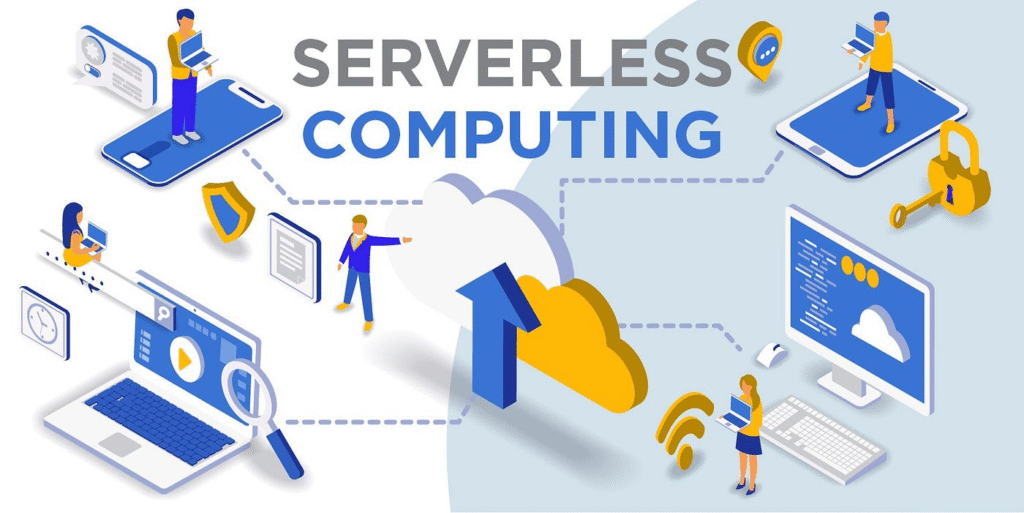Serverless computing has emerged as one of the most transformative trends in modern DevOps. By abstracting away the need to manage infrastructure, serverless platforms like AWS Lambda, Azure Functions, and Google Cloud Functions enable development teams to deploy applications with minimal overhead.
What Is Serverless Computing?
Despite its name, serverless doesn’t mean servers are no longer used—it means developers no longer have to manage them. In a serverless model, cloud providers automatically handle provisioning, scaling, and maintenance of servers, allowing developers to focus purely on code.
This is typically delivered through a model called Function as a Service (FaaS), where code is executed in response to events, such as HTTP requests, database triggers, or file uploads.
Key characteristics include:
- Event-driven execution: Code runs only when triggered
- Auto-scaling: Resources scale up or down based on traffic
- Pay-per-use: Costs are based on actual compute time
- Statelessness: Functions do not maintain state between executions
Impact on DevOps Workflows
DevOps practices focus on automating software delivery and infrastructure changes. Serverless computing aligns perfectly with these goals by offering:
- Faster CI/CD pipelines: Serverless platforms integrate seamlessly with tools like Jenkins, GitHub Actions, and GitLab CI
- Zero infrastructure management: No need to provision VMs or containers for many workloads
- Improved monitoring and observability: Built-in integrations with services like AWS CloudWatch or Azure Monitor
- Simplified rollback and updates: Functions can be versioned and rolled back independently
This allows DevOps teams to increase velocity without sacrificing reliability.
Use Case: Real-Time Data Processing
One of the most powerful serverless use cases in DevOps is real-time data processing. For example, streaming platforms like Netflix and Spotify use serverless functions to analyze user activity, detect anomalies, and customize content delivery in real time.
In a recent case study, LinkedIn migrated several parts of its user behavior pipeline to AWS Lambda, reducing compute costs by 38% and improving event processing latency by 60%.
Benefits of Serverless in DevOps
The serverless model brings a range of benefits to DevOps teams:
- Reduced operational burden: No patching, load balancing, or infrastructure setup
- Lower cost of ownership: Pay only for what you use—down to milliseconds of execution
- Global scalability: Functions are region-agnostic and scale across geographies
- Rapid prototyping: Developers can test and deploy ideas quickly without setting up environments
These advantages make serverless a go-to choice for startups, enterprise teams, and open-source contributors alike.
Security and Compliance Considerations
While serverless reduces surface area, it also introduces new security paradigms. With functions running independently, security best practices must be enforced at the code level.
Key considerations include:
- Least privilege access: Functions should have only the permissions they need
- Input validation: Protect against injection attacks and malformed data
- Auditing and logging: Use centralized logging for traceability and compliance
- API gateway protection: Ensure that endpoints are rate-limited and authenticated
Cloud providers offer built-in tools, such as AWS IAM, Azure Policy, and Google Identity-Aware Proxy, to assist with securing serverless apps.
Challenges and Limitations
Despite the advantages, serverless computing is not a silver bullet. Common challenges include:
- Cold start latency: Functions may take longer to execute after inactivity
- State management: Requires external storage solutions like Redis or S3
- Vendor lock-in: Serverless code is often tightly coupled with specific cloud APIs
- Limited runtime execution: Most providers limit function execution time (e.g., 15 minutes on AWS Lambda)
Mitigating these challenges requires thoughtful architecture, including the use of hybrid serverless models and multi-cloud strategies.
What’s Next for Serverless in DevOps?
The future of serverless is evolving beyond just FaaS. Trends include:
- Serverless containers: Services like AWS Fargate and Google Cloud Run allow containerized workloads with serverless benefits
- Stateful serverless: Tools like Temporal and Durable Functions help manage long-running workflows
- Edge computing integration: Platforms like Cloudflare Workers bring serverless to the edge for ultra-low latency
- Unified observability: Serverless-native APM tools like Datadog and New Relic are improving insight into ephemeral workloads
These advances will help DevOps teams manage increasingly complex applications with even greater speed and reliability.




